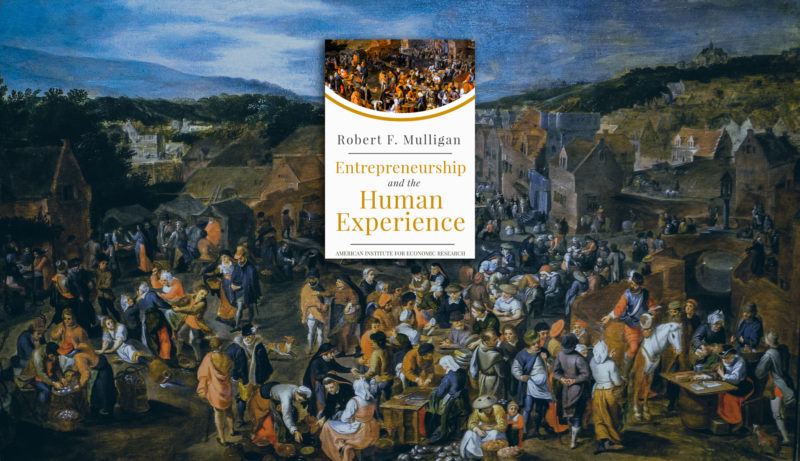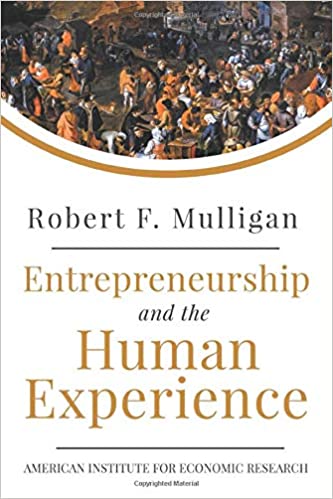Entrepreneurship and the Human Experience

Robert Mulligan, in his book Entrepreneurship and the Human Experience, takes on the noble task of contextualizing and humanizing the way we view economics, particularly the essential role of entrepreneurs. The book moves logically through a series of important and complementary topics. Those include a lesson in basic economics, an introductory explanation of how one acts as an entrepreneur, a more in-depth explanation of the function of entrepreneurs, and a refutation of central planning.
The book itself functions as an excellent application and expansion of Austrian economics, citing the works of Kirzner, Mises, Hayek, and Schumpeter who wrote extensively on the role of entrepreneurs. Mulligan is an accomplished economist himself, having taught economics at Western Carolina University for twenty years. In his book, he flexes his knowledge when he writes on topics such as the business cycle and critiques various schools of thought from Keynesianism, to Neoclassical economics, to Socialism.
Mulligan’s book cannot be more timely as it seems that the appreciation for the central role that entrepreneurs play in advancing society has become hazy. Entrepreneurs, in essence, exist to resolve the knowledge problem espoused by economists such as Hayek and Kirzner. We inhabit a system of dispersed information, where subjective value is largely unknown, preferences are unique, efficiency is suboptimal, and scarcity is a fact of life.
Knowing this, how do we deliver the services society needs to function? On page 8 Mulligan cites the work of the great Adam Smith who famously asserted that the economy was guided by an invisible hand. However, for Mulligan, this explanation is far too simplistic and leaves out an essential mechanism of the economy, entrepreneurs. Entrepreneurs move the economy and influence the market by making calculated decisions, innovating, inventing, and risk-taking. On page 174 he explains that
“To implement an entrepreneurial plan, entrepreneurs must visualize and implement a roadmap to completion to acquire the necessary resource combinations, combine them in a production process, and market the output attractively to the target market demographics, and then perhaps implement strategies to broaden their market niches.”
The economy is guided not necessarily by an abstract force but by the countless decisions made by suppliers and consumers acting in entrepreneurial ways. On page 330 he addresses how Neoclassical economists tend to view economic behavior as a set of optimization problems that one can chart using a series of equations and graphs. These equations are overly simplistic and don’t account for the highly disruptive behavior of entrepreneurs which cannot be neatly accounted for in models assuming perfect information.
In the market, entrepreneurial behavior exists because of imperfect information and inefficiency. This behavior, in turn, serves to capitalize on these deficiencies, subsequently mitigating them as a result. Ludwig von Mises explains that entrepreneurs are alert to these sorts of problems and act on market information. This could take a variety of forms such as arbitrage, in which an entrepreneur would capitalize on a discrepancy in prices between resource and product markets. It could come in the form of shifting inputs and improving efficiency to provide a cheaper or more high-quality product. It could come in the form of innovation and invention that changes the market, sending shockwaves of subsequent adjustments across all industries.
Ultimately profit is made when the desires of consumers are met and suppliers are rewarded for providing an attractive product. In particular, entrepreneurship differs from simply reacting to supply and demand because entrepreneurs tend to innovate and create new products that never before existed or occupied the minds of consumers. On page 174 Mulligan cites a quote that is commonly misattributed to Henry Ford:
“If I had asked my customers what they wanted they would have asked for a faster horse.”
Instead of having automobiles society would not have progressed past horses if entrepreneurs decided not to take risks and gamble on entirely new innovations. Meeting demand with supply is only one service entrepreneurs provide. Being able to invest talent, treasure, and risk into conjuring up experimental or innovative products that may or may not be popular is an essential function that entrepreneurs provide.
They are rewarded handsomely for success such as in the case of Steve Jobs and the iPhone, Jeff Bezos and Amazon, Elon Musk and Tesla. However, failure will mean that time and resources go to waste, which for many could be career-ending. Part of the entrepreneurial experience and human progress more generally is assuming risk in the hopes of advancing one’s condition.
We could contextualize this in a variety of ways, such as a group of college students pooling their resources to create a startup, an established firm like Apple dropping a new software update, or an immigrant moving to a new foreign land in search of better opportunity.
On page 366 Mulligan offers a fascinating analysis of two competing Austrian views on the role of entrepreneurs concerning market equilibria. One is espoused by Israel Kirzner and the other by Joseph Schumpeter. He writes that
“Schumpeterian entrepreneurs destroy equilibria, whereas Kirznerian entrepreneurs effect adjustment towards new equilibria.”
These two diametrically opposed perspectives can easily be the same person and they both serve essential functions in the economic order. Mulligan further explains that Kirznerian entrepreneurs exploit information asymmetries in the market, capitalizing on them in a way that moves the market closer to an equilibrium. He achieves this by being alert to inefficiencies and discrepancies within various markets while tailoring an entrepreneurial plan towards consumer wants.
For example, a Kirznerian entrepreneur would notice that in the summer Washington, DC becomes flooded with interns in need of short-term housing. He capitalizes on the shortage of housing by converting some properties he owns into cheap rental spaces. He noticed a disequilibrium of housing demand to supply and then made a decision that moves the market closer to equilibrium by offering more flexible housing options.
A Schumpeterian entrepreneur seeks to disrupt the market equilibrium with some sort of innovation. This version of the entrepreneur seeks to profit from moving the market away from an equilibrium rather than towards one. This individual creates new market asymmetries between supply and demand by introducing an attractive and innovative product such as the smartphone. Thus a new and immediate shortage is created by this short-term monopoly that comes from being the first to place a new product on the market. The Schumpeterian entrepreneur will then attempt to create new disruptions by introducing new features and products. Rather than trying to mitigate a shortage or a surplus like the Kirznerian, the Schumpterian creates new shortages by introducing a new product or a new surplus by finding a more efficient way to produce a product.
Both types of entrepreneurs play an indispensable role in an economic system that is as glorious as it is messy. Society should embrace these heroes as they are responsible for maintaining and growing the vast wealth of services we need to function. Deirdre McCloskey writes on the tremendous benefits that arise when society embraces enterprising and profit-driven individuals. In particular, she notes
“Ideas from and about the bourgeoisie — by an explosion after 1800 in technical ideas and a few institutional concepts, backed by a massive ideological shift toward market-tested betterment.”
Society has grown more prosperous by unleashing the spontaneous order of the market and allowing society to function through the actions of entrepreneurs. This is how grocery stores are stocked with a bounty of products, how every home has access to electricity, how almost every person has a computer in the palm of their hands. This is the product of permissionless innovation, fierce competition, and the actions of countless entrepreneurs free to take on risk with the possibility to reap the rewards.
Of course, this is not a perfectly clean process that Mulligan explains when he writes about the business cycle. Not every invention or investment is productive or efficient. This is why every so often recessions happen, which is simply when the consequences of poor decisions materialize.
As poor investments show negative returns, entrepreneurs are incentivized to reevaluate and reconfigure. Eventually, the fruits of good decisions materialize and then the economy picks up and enters a boom cycle. This is as essential and imminent as the circle of life. However, government policymakers and economists from a variety of traditions believe that somehow this process could be adjusted or eliminated. On page 247 Mulligan explains how this futile attempt to combat nature typically results in negative results. He writes
“Expansionary government policy, specifically monetary expansion, however, prevents the natural maintenance of entrepreneurial plans from being sustainably kept in mutual coordination.”
Throughout the book, Mulligan explains quite thoroughly the natural and necessary process that drives recessions and ultimately the business cycle. He engages with and critiques expansionary and stabilization policies most notably attributed to the Keynesian school of economics. In particular, he notes that expansionary policy tends to encourage increased investment at the expense of reduced savings while also incentivizing poor decision making. Furthermore, on page 285 he critiques the fiscal stimulus policies typically favored not only by Keynesians but the government officials who so enthusiastically employ them. He notes that
“One obvious shortcoming of Keynesian stabilization policy is that government purchases are not subject to the same market tests of usefulness as private expenditure.”
This goes back to the Hayekian knowledge problem which outlines how information on preferences and needs are impossible to consolidate under one roof. No organization, and certainly, no person can ever fully manage the economy. The spontaneous and seemingly infinite voluntary transactions carried out in the market produce the efficient and equitable distribution of assets in society. Consumers, not the government, decide best based on their individual preferences what is most useful and necessary.
After Mulligan takes the reader through the role of entrepreneurs and the forces acting in the market, he conveniently brings us to his final portion of the book. That is the danger and incompetency of central planning. Any basic reading of history shows that bureaucrats and politicians are easily overcome by their hubris and arrogance, believing that they can do the impossible and plan an entire economy. We have seen the results to their fullest extent in the Soviet Union, in Maoist China, in Venezuela, in North Korea and other unfortunate societies. We can even observe it in moderate quantities right here in the United States as COVID-19 lockdowns decimate small businesses and fiscal stimulus packages don’t work as intended.
An economy that relies on entrepreneurial planning, as Mulligan calls it, is flexible, vibrant, and innovative. The best results occur by dispersing economic decision making to the people with the most agency, individual consumers, and suppliers. However, as Mulligan writes on page 300
“In sharp contrast to entrepreneurs in a market economy, who bear the cost of any mistakes they make in experimental innovation, central planners do not face any such profit-and-loss discipline. Instead, it is consumers who bear the burden of the central planner’s errors of judgment in a socialist planned economy.”
Decisions dictated 10,000 miles away from the comfort of a government office can never be as precise or effective as those made in the boardroom or the kitchen table. Every decision, from what groceries to buy to the specifics of a corporate merger, would be far better executed by those who immediately benefit or suffer from the results.
Mulligan’s book very much serves as a necessary review and expansion of the work of many great Austrian economists. He lays out in plain English the fine workings of the market and the actors who participate in it. He reminds us how we got to where we are and cautions against those who believe they know better. Mulligan communicates a necessary message over the course of 378 pages detailing timeless economic wisdom and contemporary application.
Economics should not be viewed as a clean and sterile science that seeks to chart the world with equations. Rather it should seek to understand the oftentimes chaotic and messy nature of the market driven by the grit and wit of entrepreneurs. It should humble the beholder to the incomprehensible manner in which society organizes itself through free and voluntary actions, not a central dictate. As the Nobel Prize-winning economist Friedrich Hayek once said: “The curious task of economics is to demonstrate to men how little they really know about what they imagine they can design”.











